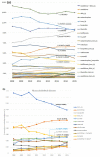Trends in Ambulatory Analgesic Usage after Myocardial Infarction: A Nationwide Cross-Sectional Study of Real-World Data
- PMID: 35326923
- PMCID: PMC8956017
- DOI: 10.3390/healthcare10030446
Trends in Ambulatory Analgesic Usage after Myocardial Infarction: A Nationwide Cross-Sectional Study of Real-World Data
Abstract
Although current guidelines for myocardial infarction (MI) recommend caution in using non-steroidal anti-inflammatory drugs (NSAIDs), real-world studies of ambulatory settings are rare. This study aimed to explore the patterns and trends of analgesic prescriptions (especially NSAIDs) among patients with a history of MI in ambulatory care settings in Korea. We analyzed real-world data from the Korea National Health Insurance Service database. Patients aged 20 years or older hospitalized with incident MI were identified between January 2007 and December 2015. Ambulatory analgesics were administered after discharge from incident hospitalization for MI, and annual trends in the prescriptions of individual analgesics were evaluated. Among the 93,597 patients with incident MI, 75,131 (80.3%) received a total of 2,081,705 ambulatory analgesic prescriptions. Prescriptions were mainly issued at primary care clinics (80.3%). Analgesics were most frequently prescribed for musculoskeletal diseases (often NSAIDs, 70.7%); aceclofenac (13.7%) and diclofenac injection (9.4%) were the frequently used NSAIDs. Additionally, significant changes were observed in the trends for some analgesics, such as loxoprofen. This study suggested that NSAIDs are commonly prescribed to patients with a history of MI. Future real-world studies are needed to elucidate the drug-disease interactions of NSAIDs prescribed after MI, especially for patients with musculoskeletal diseases.
Keywords: ambulatory analgesics; myocardial infarction; non-steroidal anti-inflammatory drugs (NSAIDs); patterns and trends; the Korea National Health Insurance Service (NHIS) database.
Conflict of interest statement
The authors declare no conflict of interest.
Figures




Similar articles
-
Prevalence and predictors of non-steroidal anti-inflammatory drug/analgesic therapeutic duplication in the South Korean ambulatory care setting.Eur J Clin Pharmacol. 2016 Jan;72(1):109-16. doi: 10.1007/s00228-015-1958-0. Eur J Clin Pharmacol. 2016. PMID: 26490355
-
Nonsteroidal Anti-inflammatory Drugs Utilization Patterns among the Elderly with Osteoarthritis at Primary Ambulatory Care Units in Busan Metropolitan City, Korea.J Prev Med Public Health. 2004 May;37(2):150-6. J Prev Med Public Health. 2004. PMID: 25178446
-
Analgesic prescribing for musculoskeletal complaints in the ambulatory care setting after the introduction and withdrawal of cyclooxygenase-2 inhibitors.Arch Phys Med Rehabil. 2009 Jul;90(7):1147-51. doi: 10.1016/j.apmr.2009.01.017. Arch Phys Med Rehabil. 2009. PMID: 19577028
-
Evaluation of prescription pattern of analgesic use among ambulatory elderly in South-Western Nigeria.Ann Afr Med. 2020 Apr-Jun;19(2):131-136. doi: 10.4103/aam.aam_57_19. Ann Afr Med. 2020. PMID: 32499470 Free PMC article.
-
[Risk of fatal/non-fatal events in patients with previous coronary heart disease/acute myocardial infarction and treatment with non-steroidal anti-inflammatory drugs].Semergen. 2018 Jul-Aug;44(5):355-363. doi: 10.1016/j.semerg.2017.07.004. Epub 2017 Sep 4. Semergen. 2018. PMID: 28882733 Review. Spanish.
Cited by
-
Health Informatics: The Foundations of Public Health.Healthcare (Basel). 2023 Mar 8;11(6):798. doi: 10.3390/healthcare11060798. Healthcare (Basel). 2023. PMID: 36981455 Free PMC article.
References
Grants and funding
LinkOut - more resources
Full Text Sources

